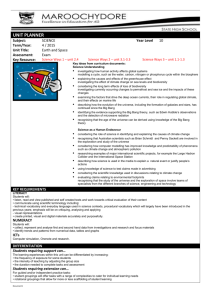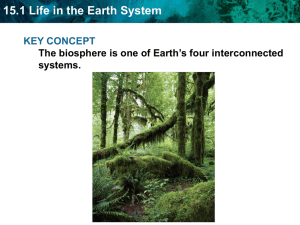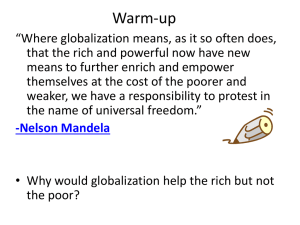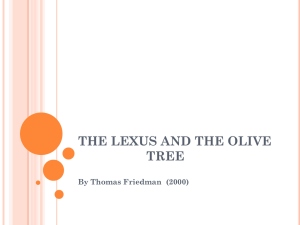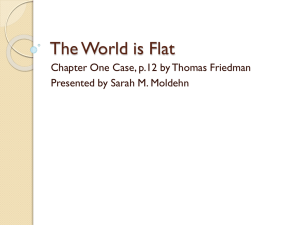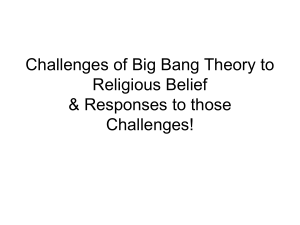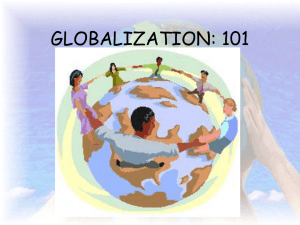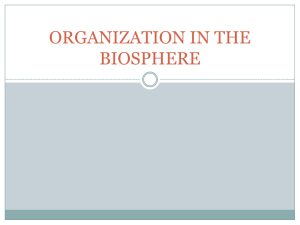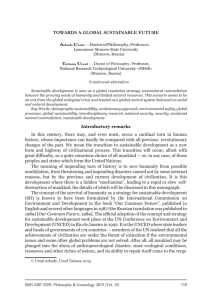the future - Big History Project
advertisement
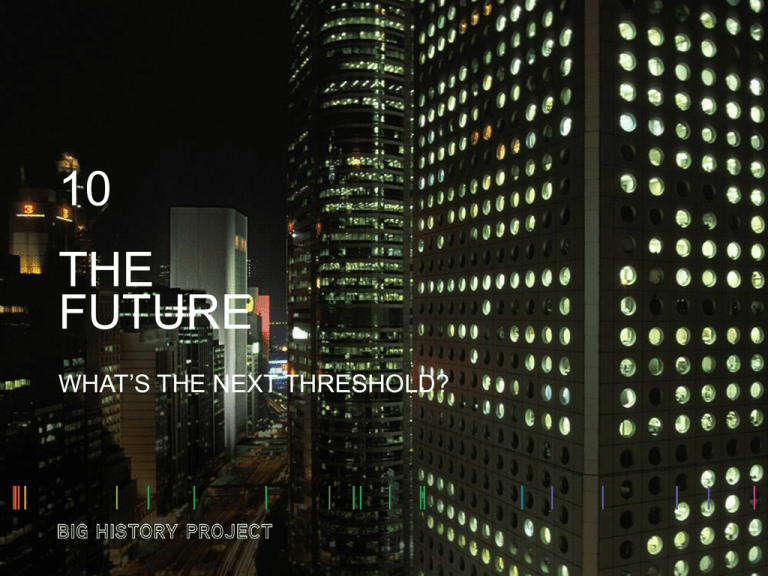
10 THE FUTURE WHAT’S THE NEXT THRESHOLD? UNIT 10 THE FUTURE CONTENTS UNIT 10 BASICS 3 Unit 10 Overview 4 Unit 10 Learning Outcomes 5 Unit 10 Lessons 6 Unit 10 Key Concepts LOOKING BACK 8 Looking Back: What Happened in Unit 9? BIG HISTORY PROJECT / UNIT 10 / THE FUTURE KEY CONTENT 10 The History of Everything 11 Globalization II: Good or Bad 12 The Atmosphere and Climate 13 A Big History of Everything 14 Complexity and the Future 15 Visions of the Future: Bill Gates 2 UNIT 10 OVERVIEW Key disciplines: Chemistry, conservation science, economics, medicine Timespan: The future Driving Question: What’s the next threshold? Threshold for this Unit: There is no new threshold for this unit BIG HISTORY PROJECT / UNIT 10 / THE FUTURE 3 UNIT 10 LEARNING OUTCOMES By the end of Unit 10, students should be able to: 1. Explain the Big History story and its defining features and patterns. 2. Identify important human end environmental issues that affect the future of our species and the biosphere. BIG HISTORY PROJECT / UNIT 10 / THE FUTURE 4 UNIT 10 LESSONS 10.0 Looking Back Big History is an unfinished story. But before we think about where we go from here, let’s take a quick look at where our 13.8-billion year adventure has taken us. 10.1 The Biosphere What does the future hold for the biosphere? Can humans find a way to balance the need for innovation to provide the food and resources needed to support the human population with the need to protect the biosphere? 10.2 Looking Forward The study of Big History inevitably leads to the future. So what’s next? Join some of the world’s great thinkers to try to predict the next threshold. BIG HISTORY PROJECT / UNIT 10 / THE FUTURE 5 UNIT 10 KEY CONCEPTS • • • • • • • • • • • • • • • • atom Big Bang Big History black hole chemistry climate change collective learning complexity democracy DNA (deoxyribonucleic acid) Earth energy entropy (the law of) fossil fuel globalization global warming • Goldilocks Conditions • HISTORY gravity BIG PROJECT / UNIT 10 / THE FUTURE • greenhouse effect • • • • • • • • • Homo sapiens individualism life Milankovitch cycles Solar System star supernova thresholds of increasing complexity Universe 6 LOOKING BACK WHAT HAPPENED IN UNIT 9? Unit 9 focused on the modern world. We learned: • How the pace of innovation and change has accelerated in the last 250 years. • How increasing speeds of communication and transportation, as well as greater connection between world zones, has led to a tremendous appetite for energy. • About the effects our species has had on the biosphere in the time since the Industrial Revolution. • Some of the ways that commerce, labor, and the global economy have changed in recent years BIG HISTORY PROJECT / UNIT 2 / THE BIG BANG 8 KEY CONTENT THE HISTORY OF EVERYTHING Video / David Christian • In a live talk at the TED conference in March 2011, David Christian describes the history of the Universe in just 18 minutes. • By scrambling an egg, Christian suggests how the Universe grows more complex through unlikely circumstances he calls Goldilocks Conditions. • He leads an audience of scholars, business leaders, and entertainers through the entire history of the Universe focusing on eight thresholds of increasing complexity – moments when Goldilocks Conditions unlocked transformations that weren’t possible beforehand. • These thresholds are the Big Bang, the formation of stars, chemical elements emerging from stars, Earth and our Solar System, life, humans, agriculture, and our modern world. BIG HISTORY PROJECT / UNIT 1 / WHAT IS BIG HISTORY? 10 GLOBALIZATION II—GOOD OR BAD? Video • Globalization has created a service economy in some societies—an economy where most people do not work in agriculture or manufacturing but in service industries like healthcare, retail, education, entertainment, and information technology. The U.S. and Europe have economies dominated by service. Traditional beliefs and practices have been scaled back or reformed to allow individuals to do more of what they want. • Globalization has also impacted the biosphere through human impact on the land and in resource use. • Democracy seems to be trending in the global age, particularly in places like Brazil, India, and South Africa, but the connection between economic growth and democracy has been uneven in places like Latin America and Africa. • Our perspective on globalization will be influenced by how the story plays out in the near future. A global pandemic, human-induced climate change, or asteroid impact could occur and wipe out humans, or life as we know it. The benefits of globalization have also been distributed unequally. None of these things is destined to happen, so the near future could very well see continued innovation and improvement in the quality of life. BIG HISTORY PROJECT / UNIT 8 / EXPANSION & INTERCONNECTION 11 THE ATMOSPHERE AND CLIMATE Video • There are may types of evidence that give us insight into what the Earth’s climate was like in the past: • Pollen grains from bogs and lake beds show which plants flourished in the past. • Tree rings provide information about temperature and precipitation levels. • Ice cores contain air bubbles that hold samples of ancient air. • The chemicals in ocean sediments contain evidence about water temperatures in the past. • The evidence shows that Earth’s climate didn’t change much during the agrarian era. However, the modern era has seen more variation. • Average temperatures began to rise in the early twentieth century. • Global temperatures are expected to rise several degrees during this century. BIG HISTORY PROJECT / UNIT 9 / ACCELERATION 12 A BIG HISTORY OF EVERYTHING Video PLEASE INSERT H2 IMAGE HERE • Big History identifies eight thresholds of increasing complexity in the history of the Universe: the Big Bang, the stars light up, new chemical elements, Earth and the Solar System, life, collective learning, agriculture, and the Modern Revolution. What will the next threshold be? • To be considered a threshold, an event has to alter things fundamentally, irreversibly changing our modern world. • Some of the possibilities for the future include: the discovery of life on Mars; our own technology overtakes us; the discovery of intelligent creatures from other planets (or the discovery of us by them); a massive catastrophe or natural disaster. • Human future is much more predictable on an astronomical scale (over billions of years). Billions of years from now the Sun will expand and sterilize the Earth. The seas will boil away, and the Sun will contract and turn into a black dwarf. Ninety percent of the energy from stars has already been used up, and the Universe will start to reverse its process and become simple and unable to create more complex things. BIG HISTORY PROJECT / UNIT 9 / ACCELERATION 13 COMPLEXITY & THE FUTURE Article / David Christian • The Universe is getting larger and it’s likely to become simpler over the next hundreds of billions of years. • Changes on Earth will happen more quickly, partially as a result of the massive effect of humans on the biosphere. • Collective learning has had positive and negative effects on the Earth in modern times. • The Anthropocene could be a new geologic epoch. • A lot rests on choices that your generation and your children’s generation, will make in the next 100 years. BIG HISTORY PROJECT / UNIT 10 / THE FUTURE 14 VISIONS OF THE FUTURE Video Talk / Bill Gates • Bill Gates considers the near and distant futures. • Gates sees positive trends in the present that bode well for the near future: slowing population growth rates, a decline in violence, and a valuing of work by people in other countries. • Gates sees a number of challenges that will need to be addressed as people transition into the near future. These challenges include finding new sources of energy and making sure the poor share in the improvements being made. • Finally, Gates has questions about the role robots will play in our day-to-day lives in the future and how a fulfilling life will be defined as people live longer and longer lives. BIG HISTORY PROJECT / UNIT 10 / THE FUTURE 15
